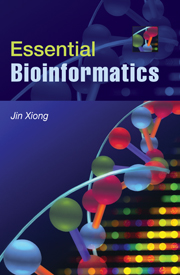Book contents
- Frontmatter
- Contents
- Preface
- SECTION I INTRODUCTION AND BIOLOGICAL DATABASES
- SECTION II SEQUENCE ALIGNMENT
- 3 Pairwise Sequence Alignment
- 4 Database Similarity Searching
- 5 Multiple Sequence Alignment
- 6 Profiles and Hidden Markov Models
- 7 Protein Motifs and Domain Prediction
- SECTION III GENE AND PROMOTER PREDICTION
- SECTION IV MOLECULAR PHYLOGENETICS
- SECTION V STRUCTURAL BIOINFORMATICS
- SECTION V GENOMICS AND PROTEOMICS
- APPENDIX
- Index
- Plate section
- References
3 - Pairwise Sequence Alignment
Published online by Cambridge University Press: 05 June 2012
- Frontmatter
- Contents
- Preface
- SECTION I INTRODUCTION AND BIOLOGICAL DATABASES
- SECTION II SEQUENCE ALIGNMENT
- 3 Pairwise Sequence Alignment
- 4 Database Similarity Searching
- 5 Multiple Sequence Alignment
- 6 Profiles and Hidden Markov Models
- 7 Protein Motifs and Domain Prediction
- SECTION III GENE AND PROMOTER PREDICTION
- SECTION IV MOLECULAR PHYLOGENETICS
- SECTION V STRUCTURAL BIOINFORMATICS
- SECTION V GENOMICS AND PROTEOMICS
- APPENDIX
- Index
- Plate section
- References
Summary
Sequence comparison lies at the heart of bioinformatics analysis. It is an important first step toward structural and functional analysis of newly determined sequences. As new biological sequences are being generated at exponential rates, sequence comparison is becoming increasingly important to draw functional and evolutionary inference of a new protein with proteins already existing in the database. The most fundamental process in this type of comparison is sequence alignment. This is the process by which sequences are compared by searching for common character patterns and establishing residue–residue correspondence among related sequences. Pairwise sequence alignment is the process of aligning two sequences and is the basis of database similarity searching (see Chapter 4) and multiple sequence alignment (see Chapter 5). This chapter introduces the basics of pairwise alignment.
EVOLUTIONARY BASIS
DNA and proteins are products of evolution. The building blocks of these biological macromolecules, nucleotide bases, and amino acids form linear sequences that determine the primary structure of the molecules. These molecules can be considered molecular fossils that encode the history of millions of years of evolution. During this time period, the molecular sequences undergo random changes, some of which are selected during the process of evolution. As the selected sequences gradually accumulate mutations and diverge over time, traces of evolution may still remain in certain portions of the sequences to allow identification of the common ancestry.
- Type
- Chapter
- Information
- Essential Bioinformatics , pp. 31 - 50Publisher: Cambridge University PressPrint publication year: 2006
References
- 2
- Cited by



